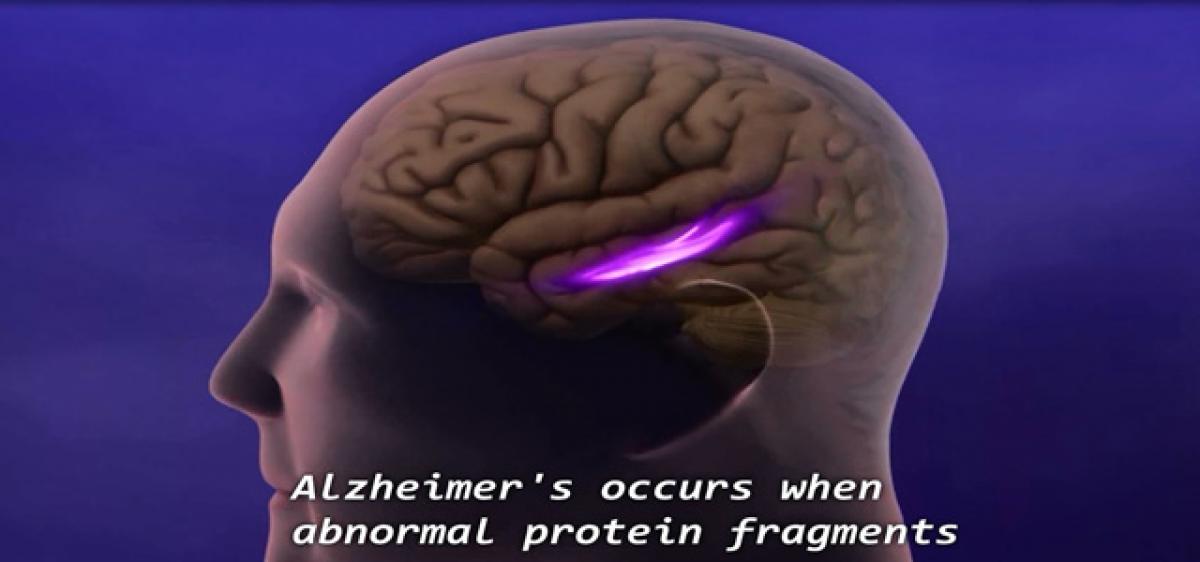Live
- Daily Horoscope for 15 December 2024: Embrace Today’s Insights of Your Zodiac Sign and Unlock Your Potential.
- Beyond The Flames
- CM warns officials of stringent action
- ‘Resignation of Avanthi Srinivas leaves no impact on YSRCP’
- Congress killers of Samvidhan: Modi
- Bejan Daruwalla’s horoscope
- Study warns: Ultra-processed foods may accelerate biological age
- CM pledges more political opportunities to Madigas
- Vizag attracts tourists as much as Kashmir
- Year-Ender 2024 Guide: Home remedies to relieve Period Pain.
Just In
Biomarkers that may enable precise diagnosis of Alzheimer’s disease discovered


Diagnosing Alzheimer’s disease and determining a patient’s prognosis is an inexact business, and that stands in the way of better personalized care and advances in treatment. A new study from The Ohio State University has identified a potential new way of confirming the disease and predicting a patient’s outlook.
Diagnosing Alzheimer’s disease and determining a patient’s prognosis is an inexact business, and that stands in the way of better personalized care and advances in treatment. A new study from The Ohio State University has identified a potential new way of confirming the disease and predicting a patient’s outlook.
First, the team of researchers discovered new physical biomarkers that could help pinpoint a diagnosis – changes to proteins found in the spinal fluid and blood of patients. In particular, as Alzheimer’s severity increased, the proteins were longer, more rigid and more clustered, said lead researcher Mingjun Zhang, a professor of biomedical engineering at Ohio State.
After finding these new clues to the disease, the research team entered information about the biomarkers and several other factors – including scores from cognitive assessments of patients – into an algorithm designed to rate the severity of illness. The researchers found that the equation could identify disease stages and progression.
“With a tool like this you may predict how fast this disease will go, and currently we can’t do that – we just know everyone is different,” Zhang said. “Looking at multiple indicators of the disease all at once increases the reliability of the diagnosis and prognosis.”
The research appears in the journal Science Advances. The information used in the study came from a database of medical information – and samples of spinal fluid and blood – from patients seen by study co-author Douglas Scharre, a professor of clinical neurology and psychiatry in the Neurological Institute at Ohio State’s Wexner Medical Center.
The experimental tools aren’t ready for clinical use yet, but could lead to improvements in treatment in multiple ways, Scharre said. It was fairly easy to see changes between normal aging and different stages of Alzheimer’s disease using these biomarkers, and to see significant changes,” he said.
urrently available medications treat only symptoms of the disease and work best with an early diagnosis. Improved diagnostic tools could help doctors sort out more quickly which patients have Alzheimer’s disease and which are experiencing cognitive decline for other reasons, Scharre said.
Early evidence from tests of experimental drugs designed to alter the disease indicate that they would work best in the early stages as well, he said. And, ideally, these biomarkers and algorithm – or something similar – could speed up discovery of new treatments to improve the outlook for those with later stages of Alzheimer’s disease. Having an easily observable biomarker that changes quickly over time would be a powerful tool for those trying to monitor the impact of their experimental treatments, Scharre said.
“A biomarker that shows that in three months, or three weeks even, that this drug is not doing a darn thing or is slowing down the disease will help us to not waste time in finding better treatments,” he said. Zhang said doctors treating patients with Alzheimer’s disease already try to take a number of factors about a given patient to estimate disease stage and to predict how quickly the disease will move.
“We’ve taken what they do and converted it to a computational model with different weights for different factors,” Zhang said. “We’re using engineering techniques to look at a human disease process, a dynamic process.”
Looking for physical changes in proteins is a growing area of interest for those seeking disease biomarkers, said Jeff Kuret, a study co-author and professor of biological chemistry and pharmacology at Ohio State. The goal is to have a sensitive test that could be applied at the early stages of Alzheimer’s disease and would not be too expensive,” Kuret said.
The study authors said it’s too soon to estimate how much tools such as this would cost if they were developed for routine use, but said that identifying a blood test – rather than one that relies on spinal fluid – would be key to minimizing risks and costs.
Kuret said this kind of test is especially promising for Alzheimer’s because it’s a relatively slow-moving illness and one in which the ability to determine stages of disease could lead to better, more personalized treatments down the road. “To be able to follow individual patients from pre-symptomatic through all stages of Alzheimer’s progression would be incredibly helpful,” he said. (Newswise)

© 2024 Hyderabad Media House Limited/The Hans India. All rights reserved. Powered by hocalwire.com






